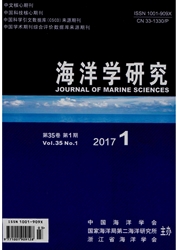

 中文摘要:
中文摘要:
2006年10月在长江口及邻近海域采用流式细胞技术测定了微微型浮游生物:聚球藻Synecho-coccus、微微型光合真核生物(picoeukaryotes)和异养浮游细菌(heterotrophic bacteria)的丰度和碳生物量,研究了其生态分布特点,并分析了其与环境因子之间的关系。结果表明,聚球藻、微微型光合真核生物和异养浮游细菌的丰度均值分别为(29.5±35.1)×103个/cm3,(0.9±0.6)×103个/cm3和(7.6±4.3)×105个/cm3(以碳计),碳生物量均值分别为(5.2±6.1)mg/m3,(1.4±0.9)mg/m3和(15.2±8.6)mg/m3(以碳计)。聚球藻、微微型光合真核生物和异养浮游细菌的丰度表现出不同的分布特征。平面分布上,聚球藻丰度呈现出近海低而外海高的分布趋势,其高值出现在长江口外的东部和东南部海域;微微型光合真核生物丰度分布趋势与聚球藻相近,其丰度高值出现在南部调查海域;异养浮游细菌丰度的高值区则分布在长江口北部外侧毗邻的海域。垂直分布上,近岸海域中微微型浮游生物在各水层中分布较均匀;远岸海域,微微型浮游生物丰度的次表层最大值现象较普遍,其中聚球藻丰度最大值出现在真光层底部;微微型光合真核生物与异养浮游细菌丰度的高值则出现在表层或真光层底部。微微型浮游生物与环境因子的相关性分析结果表明,聚球藻、微微型光合真核生物和异养浮游细菌的碳生物量均与温度呈显著正相关关系,而与营养盐、悬浮体浓度和颗粒有机碳之间存在较为密切的负相关关系。
 英文摘要:
英文摘要:
In October 2006,an autumn cruise was conducted in the adjacent sea areas of Changjiang River Estuary to investigate the abundance,carbon biomass and distribution of picoplankton(Pico) and their relationship with environmental factors.Three groups of picoplankton,that is,Synechococcus(SYN),picoeukaryotes(PEUK) and heterotrophic bacteria(HBAC) were identified.The results show that the average abundance of SYN,PEUK and HBAC was(29.5±35.1)×103 cells/cm3,(0.9±0.6)×103 cells/cm3 and(7.6±4.3)×105 cells/cm3,and the mean carbon biomass was(5.2±6.1) mg/m3,(1.4±0.9) mg/m3 and(15.2±8.6) mg/m3 respectively.The cell abundance of each group showed different distribution characteristics.As for horizontal distribution,the abundance of SYN was low nearshore and high offshore with the high value at the east and southeast areas off the estuary,and that of PEUK was similar to SYN with the high value at the southern part of the study area.The high value of HBAC appeared in the northern area off the estuary.And for the vertical direction,they were evenly distributed in nearshore waters.Their subsurface abundance maximum occurred in offshore waters with that for SYN at the bottom of euphotic layer,while that for PEUK and HBAC at the surface or bottom of euphotic layer.The results of environmental factor correlation analysis showed that there was a distinct positive correlation between picoplankton carbon biomass and water temperature,and a close negative correlation between picoplankton and nutrients,total suspended materials and particle organic carbon.
 同期刊论文项目
同期刊论文项目
 同项目期刊论文
同项目期刊论文
 期刊信息
期刊信息
